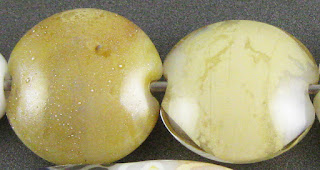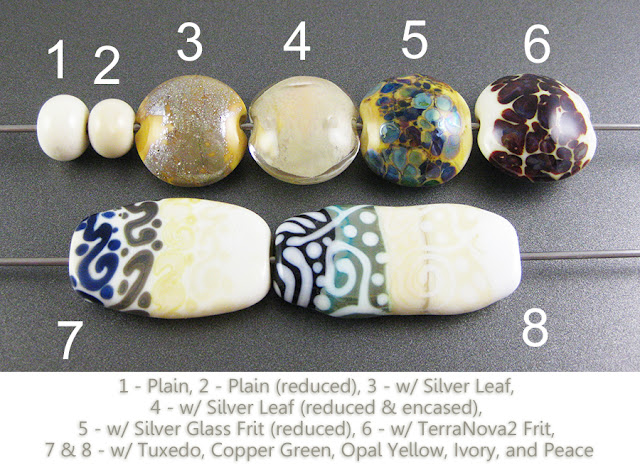OK, so you've maybe noticed that I'm on a bit of a CiM tear. And why not? New colours, even these ones that are limited runs, are pretty darned exciting for me even after more than nine years on this colour roller coaster. I won't be blogging all of the new CiMs, but I've tested most of them now.
CiM Monarch (CiM216) is a really beautiful light orange. It does strike a little in the flame, but even after striking, it is still lighter and yellower than the other oranges I've tried. I found that it melted without any irritating boiling or shocking behaviour, and was interestingly reactive with silver and with Tuxedo.
Here, you can see how it strikes a little more orange in the flame. The smaller bead is the one that I waved around in a reduction flame and therefore struck a bit.
Here is Monarch with some of the other oranges I have in my stash right now. You can see that it is much more on the yellow side than CiM Phoenix, CiM Sunset, CiM Harvest, Effetre Dark Zucca, or Effetre Light Zucca. Older batches of Light Zucca can have streaks in it that are this light, yummy orange-yellow but the most recent batch of it (pictured) is much more on the orange side.
On top of Monarch, silver turns a bit golden. It fumes the Monarch underneath a brownish colour. When the silver is reduced and encased, it looks a bluish grey colour.
Monarch makes a splendid base colour for silver glass. I was really surprised at the nice colour I got from my TerraNova2 frit on top of this colour. Rather than a strong dark line, silver glass fritty bits get more of a gentle, fuzzy brown line around them on top of Monarch.
Here you can see Monarch with Tuxedo, Copper Green, Opal Yellow, Ivory, and Peace. There isn't much to report here except that:
- Monarch really likes being under Tuxedo and rises up around the Tuxedo in strong orange halos.
- Copper Green and Monarch have a reciprocal dark line reaction, and Copper Green spreads rather a lot on top of Monarch.
Here are some other beads made with Monarch.



















































